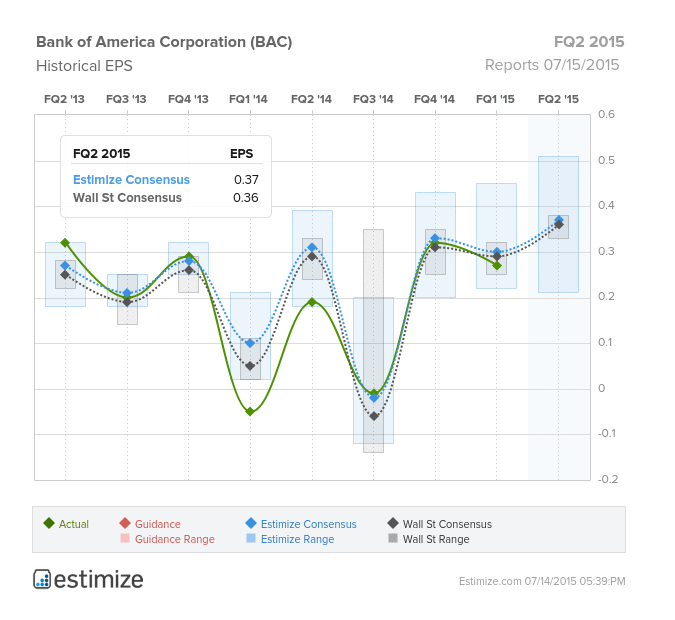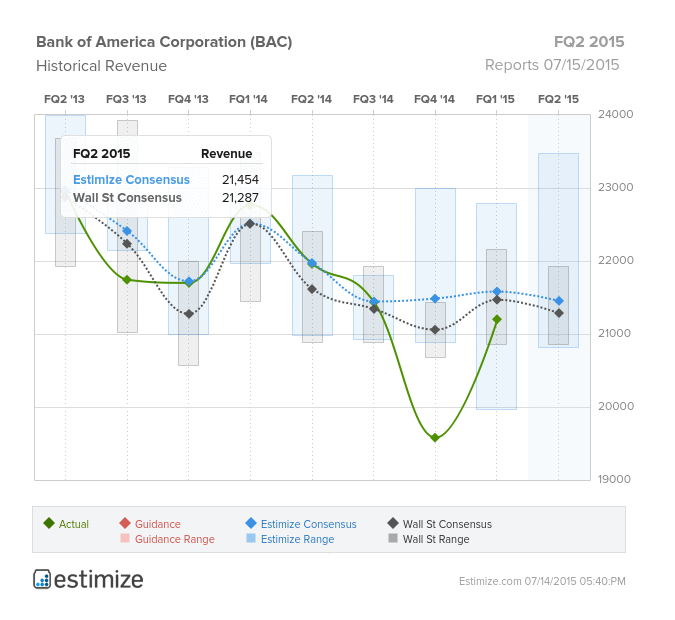Bank of America Corp (NYSE:BAC) is scheduled to announce second-quarter (2QFY15) results for the three months ended June, on Wednesday, July 15. This quarter, Wall Street is expecting EPS of $0.36, a YoY increase of 24%, and Estimize is expecting EPS of $0.37. Last quarter earnings rebounded, with YoY growth of 640%, after several negative quarters.
Revenue growth for the bank has been negative for the last 7 quarters. Last quarter, revenues hit $21.2B, representing a YoY decline of 7%. This quarter, Wall Street predicts revenues of $21.3B, with Estimize forecasting a higher figure of $21.5B. Not only has revenue growth been negative, but Bank of America has missed the Estimize consensus on the top-line for the last 4 quarters. 
One reason for dismal revenues that has affected all banks are persistently low interest rates. If the Fed increases interest rates this year, a possibility that is currently being debated, then it can be assumed that BAC will generate considerably more net revenue. Bank of America’s balance sheet, is “asset sensitive to both a parallel move in interest rates and a long-end led steepening of the yield curve,” according to its latest 10-Q. In regards to segment revenue performance, the Consumer Banking unit generates the highest revenue for the bank, almost 36%, followed closely by Global Markets and Global Wealth and Investment Management. This Banking unit is predicted to improve performance this upcoming quarter, which should offset drawbacks in Global Banking and Global Markets.
When Bank of America reports earnings, investors should focus on its return on equity (ROE) and efficiency ratio. The company’s ROE has eclipsed 5% only once on an annual basis since 2008, unlike JPMorgan Chase (NYSE:JPM) and Wells Fargo (NYSE:WFC) which regularly report ROE above 10%. At a minimum, investors will want to see that return on average common shareholders’ equity come in above the 3.68% reported in the second quarter of last year.
In terms of efficiency, Bank of America has incurred suffocating legal fees every year since the financial crisis. Even aside from that, its expenses are just too high. However, Bank of America should be back to normal efficiency after settling its multiple litigation issues. One such legal issue occurred when Bank of America came under scrutiny for their involvement in manipulating the Brazilian real (R$). Numbers are slowly improving as the bank has already settled several cases, moving it closer to profitability. While peers such as Wells Fargo and US Bancorp (NYSE:USB) have efficiency ratios between 50-60%, Bank of America posted 84.4% in Q1. Thus, only 15.6% of its net revenue was left over to cover losses from loans, return to shareholders, and pay taxes.
This quarter is expected to produce clean results, with little to no surprises, as many have become accustomed to in the post-recession landscape. Investors no doubt hope this report will serve as an indication that the bank is back on the path to profitability.
